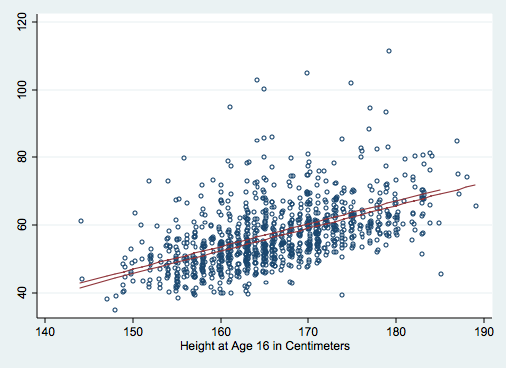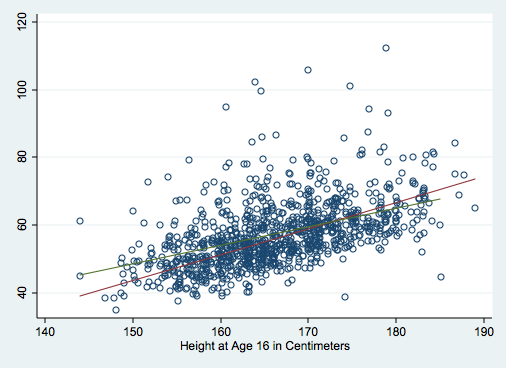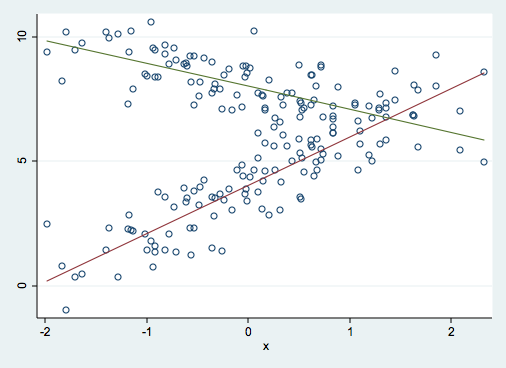Linear Statistical Models: Regression
Product Variables and Interactions
Updated for Stata 11
Product Variables
Product variables are created by multiplying one variable times another
and using the product as a predictor variable in a regression analysis.
Example: fXr = female * read
Interactions
Some researchers think that all product variables are interactions. Others restrict the
use of the term interaction to those product variables that are formed in fixed-effects
(anova type) models.
Whether you believe that all product variables are interactions or not, it is the case that
all interations can be concieved of as product variables.
Stata Example
We will use the htwt dataset to illustrate the product variables.
use http://www.philender.com/courses/data/htwt, clear
describe
Contains data from http://www.gseis.ucla.edu/courses/data/htwt.dta
obs: 1,000 NCDS Data
vars: 4 12 Feb 2001 08:32
size: 20,000 (99.6% of memory free)
-------------------------------------------------------------------------------
1. female float %9.0g sl Sex
2. height float %9.0g Height at Age 16 in Centimeters
3. weight float %9.0g Weight at Age 16 in Kilograms
4. mal float %9.0g Malaise Score at Age 22
-------------------------------------------------------------------------------
summarize
Variable | Obs Mean Std. Dev. Min Max
---------+-----------------------------------------------------
female | 1000 .509 .5001691 0 1
height | 1000 166.163 8.025138 144 189
weight | 1000 57.17209 9.656277 34.92 111.36
mal | 1000 2.591 2.842851 0 19
regress weight female height
Source | SS df MS Number of obs = 1000
---------+------------------------------ F( 2, 997) = 187.77
Model | 25486.61 2 12743.305 Prob > F = 0.0000
Residual | 67663.8236 997 67.8674259 R-squared = 0.2736
---------+------------------------------ Adj R-squared = 0.2721
Total | 93150.4336 999 93.2436773 Root MSE = 8.2382
------------------------------------------------------------------------------
weight | Coef. Std. Err. t P>|t| [95% Conf. Interval]
---------+--------------------------------------------------------------------
female | 1.343864 .6250126 2.150 0.032 .1173726 2.570355
height | .6717493 .0389541 17.245 0.000 .5953079 .7481908
_cons | -55.13182 6.658765 -8.280 0.000 -68.19863 -42.06502
------------------------------------------------------------------------------
predict p1
sort female height
graph twoway scatter weight p1 height, msym(oh i) con(. L) jitter(1) legend(off)
 regress weight i.female##c.height
Source | SS df MS Number of obs = 1000
-------------+------------------------------ F( 3, 996) = 128.78
Model | 26034.4351 3 8678.14505 Prob > F = 0.0000
Residual | 67115.9985 996 67.3855406 R-squared = 0.2795
-------------+------------------------------ Adj R-squared = 0.2773
Total | 93150.4336 999 93.2436773 Root MSE = 8.2089
------------------------------------------------------------------------------
weight | Coef. Std. Err. t P>|t| [95% Conf. Interval]
-------------+----------------------------------------------------------------
1.female | 38.26321 12.96338 2.95 0.003 12.82455 63.70188
height | .7706638 .052059 14.80 0.000 .6685058 .8728217
|
female#|
c.height |
1 | -.2227448 .0781214 -2.85 0.004 -.3760463 -.0694434
|
_cons | -72.01376 8.892743 -8.10 0.000 -89.46442 -54.56309
------------------------------------------------------------------------------
twoway (scatter weight height, msym(Oh) jitter(2))(lfit weight height if ~female) ///
(lfit weight height if female), legend(off)
regress weight i.female##c.height
Source | SS df MS Number of obs = 1000
-------------+------------------------------ F( 3, 996) = 128.78
Model | 26034.4351 3 8678.14505 Prob > F = 0.0000
Residual | 67115.9985 996 67.3855406 R-squared = 0.2795
-------------+------------------------------ Adj R-squared = 0.2773
Total | 93150.4336 999 93.2436773 Root MSE = 8.2089
------------------------------------------------------------------------------
weight | Coef. Std. Err. t P>|t| [95% Conf. Interval]
-------------+----------------------------------------------------------------
1.female | 38.26321 12.96338 2.95 0.003 12.82455 63.70188
height | .7706638 .052059 14.80 0.000 .6685058 .8728217
|
female#|
c.height |
1 | -.2227448 .0781214 -2.85 0.004 -.3760463 -.0694434
|
_cons | -72.01376 8.892743 -8.10 0.000 -89.46442 -54.56309
------------------------------------------------------------------------------
twoway (scatter weight height, msym(Oh) jitter(2))(lfit weight height if ~female) ///
(lfit weight height if female), legend(off)

Interpreting the Product Variable
One way of interpreting the product variable is to think of it as examining the the difference
in the regression slopes for, in this instance, males and females. Here is what
the separate regressions would look like in Stata.
sort female
by female: regress weight height
-> female = male
Source | SS df MS Number of obs = 491
-------------+------------------------------ F( 1, 489) = 205.86
Model | 14767.4161 1 14767.4161 Prob > F = 0.0000
Residual | 35077.9966 489 71.7341443 R-squared = 0.2963
-------------+------------------------------ Adj R-squared = 0.2948
Total | 49845.4127 490 101.725332 Root MSE = 8.4696
------------------------------------------------------------------------------
weight | Coef. Std. Err. t P>|t| [95% Conf. Interval]
-------------+----------------------------------------------------------------
height | .7706638 .0537125 14.35 0.000 .6651279 .8761996
_cons | -72.01376 9.175196 -7.85 0.000 -90.04143 -53.98608
------------------------------------------------------------------------------
-> female = female
Source | SS df MS Number of obs = 509
-------------+------------------------------ F( 1, 507) = 94.36
Model | 5962.65403 1 5962.65403 Prob > F = 0.0000
Residual | 32038.0019 507 63.1913253 R-squared = 0.1569
-------------+------------------------------ Adj R-squared = 0.1552
Total | 38000.6559 508 74.8044408 Root MSE = 7.9493
------------------------------------------------------------------------------
weight | Coef. Std. Err. t P>|t| [95% Conf. Interval]
-------------+----------------------------------------------------------------
height | .5479189 .056406 9.71 0.000 .4371007 .6587372
_cons | -33.75054 9.134041 -3.70 0.000 -51.69577 -15.80531
------------------------------------------------------------------------------
Note that the regression coefficient for height is significant in each of the two models and that
there is a fairly large difference in the two constants.
Doing the Arithmetic Manually
Let's start with the regression equation from the model with the product variable:
weight' = -72.01 + 38.26*female + .77*height - .22*fxh
When the female = male (female = 0), the formula above reduces to:
weight' = -72.01 + 38.26*female + .77*height - .22*female*height
weight' = -72.01 + 38.26*0 + .77*height - .22*0*height
weight' = -72.01 + 38.26*0 + .77*height - 0
weight' = -72.01 + .77*height
Now when female = female (female=1), the formula above reduces to:
weight' = -72.01 + 38.26*female + .77*height - .22*female*height
weight' = -72.01 + 38.26*1 + .77*height - .22*1*height
weight' = -72.01 + 38.26 + .77*height - .22*height
weight' = -33.75 + .55*height
In this example, short females tend to be heavier that corresponding males but tall females
tend to be lighter.
Example 2
This time we will create the interaction on the fly.
use http://www.philender.com/courses/data/hsbdemo, clear
regress write i.female##c.socst
Source | SS df MS Number of obs = 200
-------------+------------------------------ F( 3, 196) = 49.26
Model | 7685.43528 3 2561.81176 Prob > F = 0.0000
Residual | 10193.4397 196 52.0073455 R-squared = 0.4299
-------------+------------------------------ Adj R-squared = 0.4211
Total | 17878.875 199 89.843593 Root MSE = 7.2116
------------------------------------------------------------------------------
write | Coef. Std. Err. t P>|t| [95% Conf. Interval]
-------------+----------------------------------------------------------------
1.female | 15.00001 5.09795 2.94 0.004 4.946132 25.05389
socst | .6247968 .0670709 9.32 0.000 .4925236 .7570701
|
female#|
c.socst |
1 | -.2047288 .0953726 -2.15 0.033 -.3928171 -.0166405
|
_cons | 17.7619 3.554993 5.00 0.000 10.75095 24.77284
------------------------------------------------------------------------------
Here is the interpretation of each of the terms in the model.
_cons = 17.7619 -- This is the expected value when female = 0 (males) and
socst = 0.
1.female = 15.00001 -- This is how much the expected value will increase when
female = 1 (females) and socst = 0 (15.00001 + 17.7619 = 32.76191).
socst = .6247968 -- This is the slope for write regressed on read
when female = 0 (males).
female#c.socst = -.2047288 -- This is how the the slope will change when
female = 1 (females) (.6247968 - .2047288 = .420068).
This can be shown by running separate regressions for males and females.
bysort female: regress write socst
-> female= male
Source | SS df MS Number of obs = 91
---------+------------------------------ F( 1, 89) = 79.62
Model | 4513.09285 1 4513.09285 Prob > F = 0.0000
Residual | 5044.57748 89 56.6806458 R-squared = 0.4722
---------+------------------------------ Adj R-squared = 0.4663
Total | 9557.67033 90 106.196337 Root MSE = 7.5287
------------------------------------------------------------------------------
write | Coef. Std. Err. t P>|t| [95% Conf. Interval]
---------+--------------------------------------------------------------------
socst | .6247968 .0700195 8.923 0.000 .4856696 .7639241
_cons | 17.7619 3.711281 4.786 0.000 10.38766 25.13613
------------------------------------------------------------------------------
-> female= female
Source | SS df MS Number of obs = 109
---------+------------------------------ F( 1, 107) = 41.48
Model | 1996.12858 1 1996.12858 Prob > F = 0.0000
Residual | 5148.86224 107 48.1202079 R-squared = 0.2794
---------+------------------------------ Adj R-squared = 0.2726
Total | 7144.99083 108 66.1573225 Root MSE = 6.9369
------------------------------------------------------------------------------
write | Coef. Std. Err. t P>|t| [95% Conf. Interval]
---------+--------------------------------------------------------------------
socst | .420068 .0652213 6.441 0.000 .2907745 .5493615
_cons | 32.7619 3.514715 9.321 0.000 25.79439 39.72942
------------------------------------------------------------------------------
Doing the Arithmetic Manually
Let's start with the regression equation from the model with the product variable:
write' = 17.76 + .625*socst + 15.*female - .205*fXs
When the female = male (female = 0), the formula above reduces to:
write' = 17.76 + .625*socst + 15*0 - .205*0*socst
write' = 17.76 + .625*socst + 0 - 0
write' = 17.76 + .625*socst
Now when female = female (female=1), the formula above reduces to:
write' = 17.76 + .625*socst + 15.*1 - .205*1*socst
write' = 17.76 + .625*socst + 15. - .205*socst
write' = 32.76 + .42*socst
Solving for the Crossing Point
Set the male equation equal to the female equation and solve for socst.
17.76 + .625*socst + 15*0 - .205*0*socst = 17.76 + .625*socst + 15*1 - .205*1*socst
17.76 + .625*socst = 17.76 + .625*socst + 15 - .205*socst
17.76 - 17.76 + .625*socst - .625*socst = 15 - .205*socst
0 = 15 - .205*socst
.205*socst = 15
socst = 15/.205
socst = 73.170732
Thus, when socst = 73.170732 the predicted write scores for males and females are equal.
When socst < 73.170732 the predicted write score for females is greater than for
males and when socst > 73.170732 the predicted score for males is greater than for
females.
Another Example
use http://www.philender.com/courses/data/reginteraction, clear
describe
Contains data from reginteraction.dta
obs: 200
vars: 4 27 Oct 2004 11:31
size: 4,000 (99.9% of memory free)
-------------------------------------------------------------------------------
storage display value
variable name type format label variable label
-------------------------------------------------------------------------------
id float %9.0g
y float %9.0g
x float %9.0g
grp float %9.0g 0/1 variable
-------------------------------------------------------------------------------
tab grp
0/1 |
variable | Freq. Percent Cum.
------------+-----------------------------------
0 | 100 50.00 50.00
1 | 100 50.00 100.00
------------+-----------------------------------
Total | 200 100.00
univar y x
-------------- Quantiles --------------
Variable n Mean S.D. Min .25 Mdn .75 Max
-------------------------------------------------------------------------------
y 200 6.04 2.57 -0.95 3.97 6.72 8.04 10.59
x 200 0.03 0.93 -1.98 -0.63 0.04 0.66 2.32
-------------------------------------------------------------------------------
/* regression for whole sample */
regress y x
Source | SS df MS Number of obs = 200
-------------+------------------------------ F( 1, 198) = 6.91
Model | 44.2818817 1 44.2818817 Prob > F = 0.0092
Residual | 1268.60934 198 6.4071179 R-squared = 0.0337
-------------+------------------------------ Adj R-squared = 0.0288
Total | 1312.89123 199 6.59744335 Root MSE = 2.5312
------------------------------------------------------------------------------
y | Coef. Std. Err. t P>|t| [95% Conf. Interval]
-------------+----------------------------------------------------------------
x | .5068139 .1927822 2.63 0.009 .1266441 .8869837
_cons | 6.025549 .1790882 33.65 0.000 5.672384 6.378714
------------------------------------------------------------------------------
/* regression with categorical variable but no interaction */
regress y x grp
Source | SS df MS Number of obs = 200
-------------+------------------------------ F( 2, 197) = 155.18
Model | 803.114016 2 401.557008 Prob > F = 0.0000
Residual | 509.777211 197 2.58770158 R-squared = 0.6117
-------------+------------------------------ Adj R-squared = 0.6078
Total | 1312.89123 199 6.59744335 Root MSE = 1.6086
------------------------------------------------------------------------------
y | Coef. Std. Err. t P>|t| [95% Conf. Interval]
-------------+----------------------------------------------------------------
x | .5068139 .1225159 4.14 0.000 .2652028 .748425
grp | 3.895721 .2274951 17.12 0.000 3.447083 4.344359
_cons | 4.077688 .1609098 25.34 0.000 3.760361 4.395015
------------------------------------------------------------------------------
/* regression with interaction */
regress y c.x##i.grp
Source | SS df MS Number of obs = 200
-------------+------------------------------ F( 3, 196) = 477.60
Model | 1154.90449 3 384.968163 Prob > F = 0.0000
Residual | 157.986737 196 .806054781 R-squared = 0.8797
-------------+------------------------------ Adj R-squared = 0.8778
Total | 1312.89123 199 6.59744335 Root MSE = .89781
------------------------------------------------------------------------------
y | Coef. Std. Err. t P>|t| [95% Conf. Interval]
-------------+----------------------------------------------------------------
x | 1.935305 .0967014 20.01 0.000 1.744596 2.126014
1.grp | 3.985859 .1270422 31.37 0.000 3.735314 4.236404
|
grp#c.x |
1 | -2.856982 .1367564 -20.89 0.000 -3.126685 -2.587279
|
_cons | 4.032619 .0898324 44.89 0.000 3.855457 4.209781
------------------------------------------------------------------------------
lincom x /* slope for grp==0 */
( 1) x = 0
------------------------------------------------------------------------------
y | Coef. Std. Err. t P>|t| [95% Conf. Interval]
-------------+----------------------------------------------------------------
(1) | 1.935305 .0967014 20.01 0.000 1.744596 2.126014
lincom _cons /* constant for grp==0 */
( 1) _cons = 0
------------------------------------------------------------------------------
y | Coef. Std. Err. t P>|t| [95% Conf. Interval]
-------------+----------------------------------------------------------------
(1) | 4.032619 .0898324 44.89 0.000 3.855457 4.209781
lincom x + 1.grp#c.x /* slope for grp==1 */
( 1) x + 1.grp#c.x = 0
------------------------------------------------------------------------------
y | Coef. Std. Err. t P>|t| [95% Conf. Interval]
-------------+----------------------------------------------------------------
(1) | -.9216771 .0967014 -9.53 0.000 -1.112386 -.7309683
lincom _cons + 1.grp /* constant for grp==1 */
( 1) 1.grp + _cons = 0
------------------------------------------------------------------------------
y | Coef. Std. Err. t P>|t| [95% Conf. Interval]
-------------+----------------------------------------------------------------
(1) | 8.018478 .0898324 89.26 0.000 7.841316 8.19564
twoway (scatter y x, msym(Oh))(lfit y x if grp==0)(lfit y x if grp==1), legend(off)

Linear Statistical Models
Phil Ender, 20sep10, 4may06, 3feb04; 14jan00
 regress weight i.female##c.height
Source | SS df MS Number of obs = 1000
-------------+------------------------------ F( 3, 996) = 128.78
Model | 26034.4351 3 8678.14505 Prob > F = 0.0000
Residual | 67115.9985 996 67.3855406 R-squared = 0.2795
-------------+------------------------------ Adj R-squared = 0.2773
Total | 93150.4336 999 93.2436773 Root MSE = 8.2089
------------------------------------------------------------------------------
weight | Coef. Std. Err. t P>|t| [95% Conf. Interval]
-------------+----------------------------------------------------------------
1.female | 38.26321 12.96338 2.95 0.003 12.82455 63.70188
height | .7706638 .052059 14.80 0.000 .6685058 .8728217
|
female#|
c.height |
1 | -.2227448 .0781214 -2.85 0.004 -.3760463 -.0694434
|
_cons | -72.01376 8.892743 -8.10 0.000 -89.46442 -54.56309
------------------------------------------------------------------------------
twoway (scatter weight height, msym(Oh) jitter(2))(lfit weight height if ~female) ///
(lfit weight height if female), legend(off)
regress weight i.female##c.height
Source | SS df MS Number of obs = 1000
-------------+------------------------------ F( 3, 996) = 128.78
Model | 26034.4351 3 8678.14505 Prob > F = 0.0000
Residual | 67115.9985 996 67.3855406 R-squared = 0.2795
-------------+------------------------------ Adj R-squared = 0.2773
Total | 93150.4336 999 93.2436773 Root MSE = 8.2089
------------------------------------------------------------------------------
weight | Coef. Std. Err. t P>|t| [95% Conf. Interval]
-------------+----------------------------------------------------------------
1.female | 38.26321 12.96338 2.95 0.003 12.82455 63.70188
height | .7706638 .052059 14.80 0.000 .6685058 .8728217
|
female#|
c.height |
1 | -.2227448 .0781214 -2.85 0.004 -.3760463 -.0694434
|
_cons | -72.01376 8.892743 -8.10 0.000 -89.46442 -54.56309
------------------------------------------------------------------------------
twoway (scatter weight height, msym(Oh) jitter(2))(lfit weight height if ~female) ///
(lfit weight height if female), legend(off)

